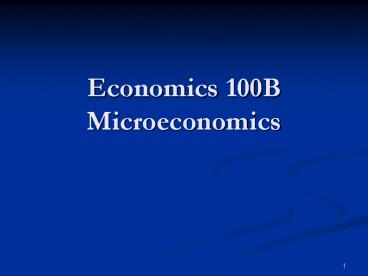Economics 100B Microeconomics - PowerPoint PPT Presentation
1 / 22
Title:
Economics 100B Microeconomics
Description:
Oligopoly. Week 6. 13. Monopoly. Week 4, 5. 12. General Eq. Week 3, 4 ... Oligopoly (Chapter 14): Homogeneous oligopoly (p415-424) Cartel model. Cournot model ... – PowerPoint PPT presentation
Number of Views:253
Avg rating:3.0/5.0
Title: Economics 100B Microeconomics
1
Economics 100BMicroeconomics
2
Announcements
- Recall
- Final on Tuesday, June 12 7-10pm
- Extra office hours
- Me Friday, June 8 10-12pm
- JJ Monday, June 11 1.30-2.30pm
3
Course Outline
4
Todays Plan
- Externalities Private solutions
- Externalities Public solutions
- Review for the final
5
I. Private Solutions
- The missing market problem can be solved by
establishing property rights
6
Coase Theorem (1)
- In the presence of externalities, the resulting
allocation will be efficient if - property rights are well-defined
- bargaining costs are zero
7
Steel Producer Assigned Rights
Price
MC
Fisherys willingness to pay for reduced steel
production
There is scope for continued bargaining over
reduction of steel production as long as sgts
MCs
D
ps
Steel producers marginal loss in profits
Quantity of steel
s
s
8
Coase Theorem (2)
- The initial assignment of rights is irrelevant
- subsequent trading will always achieve the same,
efficient equilibrium
9
Fishery Assigned Rights
Price
MC
Steel producers willingness to pay for increased
steel production
There is scope for continued bargaining over
reduction of steel production as long as slts
MCs
D
ps
Marginal loss in profits to fishery
Quantity of steel
s
s
10
Limitations of the Theorem
- Applies most readily to localized externalities
- difficulties in assigning costs/benefits to
firms/individuals - free-rider and hold-out problems with large
numbers of negotiators
11
II. Public Solutions
- Incentive-based solutions originated with Pigou,
who suggested that the most direct solution would
be to tax (or subsidize) the externality-creating
entity
12
Pigouvian Corrective Tax
Price
MC
MCs t
MCs
A tax equal to these additional marginal costs
(at s) will reduce output to the socially
optimal level
D
ps
t
Quantity of steel
s
s
13
Negative Production Externality
- Pigouvian corrective tax
14
Limitations
- Determining the appropriate tax may require a
prohibitive amount of information
15
III. Review for Final
- Logistics
- Peterson Hall 102
- Tuesday, June 12, 7-10pm
- Exam lasts 3 hours
- No calculators or other aids allowed
- Bring a blue book (we will reassign blue books
before the exam) - Exam is worth a total of 100 points
- Allocate your time wisely
16
A. Topics Covered
- Midterms program
- Applied competitive analysis (Chapter 11)
- General equilibrium and welfare (Chapter 12)
- Models of Monopoly (Chapter 13)
- Profit maximization (p385-391)
- Inefficient production (p391-394)
- Price discrimination (p397-404)
17
Topics Covered
- Oligopoly (Chapter 14)
- Homogeneous oligopoly (p415-424)
- Cartel model
- Cournot model
- Stackelberg model
- Bertrand model (see lecture notes 6)
- Spatial differentiation (p426-428)
18
Topics Covered
- Game Theory (Chapter 15)
- Basics (p440-451)
- Repeated Games (p451-453 and p455-456)
- Entry deterrence (p457-460)
- Games of incomplete information (p463-464)
19
Topics Covered
- Uncertainty (Chapter 18 and 19)
- Expected-Utility (p533-538)
- Risk Aversion (p538-545)
- State-contingent preferences (p545-552)
- Insurance and information (p565-573)
20
Topics Covered
- Externalities (Chapter 20)
- Definition, Inefficiency, and Solution (p586-595)
21
B. Example 1 Monopoly
- Assume the following
- Consumer demand Q100-(1/2)P
- Cost function C(Q)Q225
22
Example 2 Duopoly
- Assume the following
- Inverse demand curve f(Q) P 1 Q
- Firm 1s cost function C(q1) 0
- Firm 2s cost function C(q2) 0
- Total output Q q1 q2












![Economics, 6th, Parkin, 2004, Chapter 9: ???? [?1?] PowerPoint PPT Presentation](https://s3.amazonaws.com/images.powershow.com/7338318.th0.jpg?_=201511040311)


















